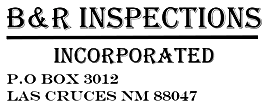

B&R Home Inspections Inc.
P.O. Box 3012
Las Cruces NM 88047
Las Cruces NM - Home-Commercial Inspections


Why Hire an InterNACHI Certified Professional Inspector®?
InterNACHI inspectors are certified and trained by the International Association of Certified Home Inspectors, the world’s largest nonprofit association of residential and commercial property inspectors. InterNACHI provides its members with accredited training and education, free benefits, expert advice, and peer support—all to help them serve their homeowner clients by providing them with the highest-quality inspections for their largest investments.



"Welcome to B&R Inspections Inc., your premier choice for meticulous home inspections in Las Cruces, New Mexico. Our dedicated team of certified inspectors is committed to ensuring the safety, integrity, and value of your property investment. Specializing in comprehensive evaluations of residential properties in Las Cruces and its surrounding areas, we delve into every aspect of your home, from its structural foundation to electrical systems, plumbing, roofing, and more. At B&R Inspections Inc., our focus is on thoroughness and attention to detail, providing you with a comprehensive report that empowers you with insights into the condition of your home. Whether you're buying, selling, or maintaining your property, trust B&R Inspections Inc. to deliver accurate assessments, professional guidance, and peace of mind for your most significant investment."

"At B&R Inspections Inc. in Las Cruces, New Mexico, we are committed to delivering meticulous and comprehensive home inspection services to meet our clients' unique needs. Our team of certified inspectors possesses the expertise to evaluate every facet of a property thoroughly, encompassing structural integrity, electrical, plumbing, HVAC systems, roofing, and more. We strive to empower homebuyers, sellers, and homeowners by providing detailed insights into their properties and facilitating well-informed decisions about their investments. Known for our precision, attention to detail, and dedication to clarity, our inspection reports serve as valuable resources. Whether navigating a real estate transaction, ensuring ongoing property maintenance, or seeking a true understanding of your property's condition, trust B&R Inspections Inc. as your reliable, professional, and expert partner in home inspections."
Home inspection tips - HVAC systems
Home inspection tips - Roofing Systems
Home inspection tips - Electrical Systems

We inspect the plumbing systems for any leaks or deficiencies.

We inspect Mobile home utilizing the Standards of practice for mobile home inspections.

We inspect the roofing system for any damage or areas in need of repair.

We inspect the electrical systems for safety and required installed safety devices.

We provide warranty inspections for new homes that approaching the 1 year warranty.

We inspect Swimming pool systems to ensure proper operation and safety.

We take safety serious and ensure proper safety inspections and procedures.

We inspect the exterior structure and components of the outer wall structures

We Inspect fireplaces and the chimney structures. Gas operation testing.

We inspect for any moisture intrusion or evidence of moisture penetration.

We inspect kitchens and all permanently installed appliances for operation and safety.

We inspect any attached decks for safety and proper construction.
